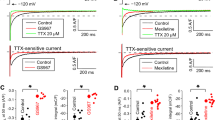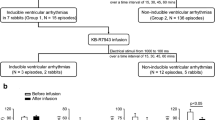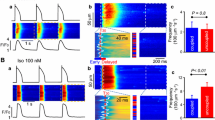Abstract.
We previously showed that a canine model of chronic heart failure (HF) produced by multiple coronary microembolizations manifests ventricular arrhythmias similar to those observed in patients with chronic HF. In the present study, we used single canine cardiomyocytes isolated from the left ventricle (LV) of normal dogs (n = 13) and dogs with HF (n = 15) to examine the cellular substrate of these arrhythmias. Action potentials (APs) and ion currents were measured by perforated and whole cell patch clamp, respectively. We found prolonged APs and alterations of AP duration resulting in early afterdepolarizations (EADs) at the low pacing rates of 0.5 Hz and 0.2 Hz. Na+ channel blockers saxitoxin (STX, 100 nM) and lidocaine (90 μM) reduced AP duration dispersion and abolished EADs in HF cardiomyocytes. The steady-state current (Iss)-voltage relation, in the voltage range from −25 mV to 25 mV analogous to the AP plateau level, was significantly shifted inward in HF cardiomyocytes. STX and lidocaine shifted the Iss-voltage relationship in an outward direction. The shifts produced by both drugs was significantly greater in cardiomyocytes of dogs with HF, indicating an increase in inward current. In the experimental configuration in which K+ currents were blocked, the density of the steady-state Ca2+ current (ICa) was found to decrease in HF cardiomyocytes by approximately 33%. In contrast, the density of the steady-state Na+ current (INa) significantly (P < 0.01) increased in HF cardiomyocytes (0.17 ± 0.06 pA/pF) compared with normal cells (0.08 ± 0.02 pA/pF). The relative contribution of INa to the net inward current was greater in HF cardiomyocytes, as evident from the increased ratio of INa/ICa (from 0.22 to 0.68). These observations support a hypothesis that anomalous repolarization of HF cardiomyocytes is due, at least in part, to an increased steady-state inward Na+ current.
Similar content being viewed by others
Author information
Authors and Affiliations
Additional information
Received 1 February 1999; accepted 2 February 1999
Rights and permissions
About this article
Cite this article
Undrovinas, A., Maltsev, V. & Sabbah, H. Repolarization abnormalities in cardiomyocytes of dogs with chronic heart failure: role of sustained inward current. CMLS, Cell. Mol. Life Sci. 55, 494–505 (1999). https://doi.org/10.1007/s000180050306
Issue Date:
DOI: https://doi.org/10.1007/s000180050306




